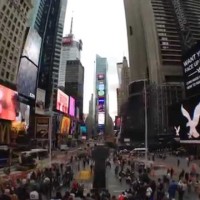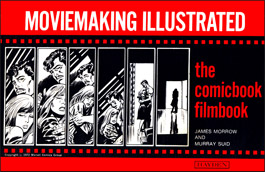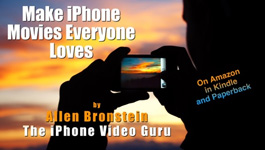Audiences focus on the leading actors: Marilyn, Bogie, Jack, Garbo. But such performers aren’t the only draw in a film. Savvy movie makers have long known that a movie prop can have great dramatic significance.And so we have such memorable movie props as the black bird in The Maltese Falcon, the light sabers in Star Wars, Dorothy’s ruby slippers in The Wizard of Oz, and the wine bottle in Hitchcock’s Notorious.
Props is a shortened form of “properties,” referring to things owned by a theater company. The expression predates Shakespeare. So we’re talking about an old element of theater. Yet over the years, the power of props has not diminished.
The book featured in Erez Sitzer’s I Love You Too is a stunning new example. In the following interview, the director talks about the book, the making of this short iPhone movie—an entry in this year’s iPhone Film Festival—and other aspects of his approach to moviemaking.
MMM: You explained on the iPhone Film Festival site that you made the movie to honor your parents and to honor loving relationships in general. Could you please tell us how you got the idea of using the book?
Erez: The best ideas happen when different thoughts converge. I LOVE YOU TOO was the result of a crash of simultaneous ideas and experiences. I was listening to Peter Gabriel sing The Book of Love while I was flipping through a book about life purpose at the same moment as I realised that my parents upcoming 50th anniversary deserved a special gift. As I flipped the pages of the book two things occurred: I serendipitously landed on page 50 (their anniversary number) and also noticed the word “love” on the page. That`s when I saw a hint of the film. It appeared like a far-off landscape, without detail, but clearly there, beckoning. The structure of the film was initially complex, and I was often stumped by how to integrate everything. As I continued working the layers of the structure just seemed to integrate.
MMM: Why did you decide to use the iPhone to shoot your movie?
Erez: Someone once offered this advice about buying a blender: the best one is the one you already have in your kitchen. The iPhone is what I had in my kitchen. I shoot all my films with the iPhone cause nothing in my kitchen has changed.
MMM: Did you encounter any problems during the production?
Erez: Every shoot has problems. Thats the fun and frustration of making films. The two biggest lessons I always try to remember are these: shoot as many times as you can from as many angles as you can so you have lots to work with in post production, and never stop shooting once the scene is set up. Often the best shots happen when the camera isn’t turned. Solution: keep rolling.
MMM: How did you become a filmmaker? Did you attend film school? study with a master?
Erez: I started making films from scratch a year and half ago. Making films was born out of a morning run up the steps of a nearby hill. My father`s 70th birthday was coming up and I found myself counting the hillside steps as I ran up wondering if there were 70 steps. If there were 70, I thought that would be kinda cool to express in a film medium, the idea being that life is like a series of steps. Problem: I had never made any films before and knew literally zero about film making. I took my iPhone and shot the film frame by frame on a cold morning. I used a simple time lapse app on my early iPhone and because I had to film the whole of it in one go I nearly got frostbite. It was early on a cold autumn morning, and I must have clicked the camera 5000 times before I got everything in one go. That first film is here. At the time I knew zero about editing, and for audio I depended on the app`s built-in features. Now I look back at that first effort and think, wow, I really ought to remake that film. Note: it was ginkgo season in Japan and so I used gingko nuts that I had collected to number the steps. Gingko is famous as a memory aid. But it sure didn’t help my memory. Because of the cold and strain of clicking the camera, I often forgot what number I was laying down and had to start from the beginning. Anyway, that first film effort made me curious and hungry to learn more about editing. Soon thereafter I started studying on the net. Really, just basics. But it made me want to make another movie.
MMM: Which was….?
Erez: I Remembered. This film demanded a greater effort. Again, someones birthday. I had three months to create something worthwhile. I call it my second film, but really, it is my first since i was responsible for all the editing. You can see that film here.I fell in love with film making after this second effort. I was hooked.
MMM: You mention the gingko season. Do you live in Japan?
Erez: I came to Japan 25 years ago after a stint in Thailand with the U.S. Peace Corps. At the end of my assignment I wanted to continue going East. That meant Japan. Any more East would have brought me right back to America, and as everyone knows, that`s West. And I was set on going East.
MMM: Could you give us some advice on filmmaking?
Erez: All I can do is point out how I work. The way I make films is simple. I step into them. Usually it`s the dynamic of the music that pulls me in. Once in, I`m not doing anything but making the film. I get caught in the dance of imagery and scenes, and eventually ideas about how to structure zoom into my consciousness and I try to capture those ideas. With my most recent film, I wanted every second of the film to mean something or matter. Otherwise it got cut. A film is only as good as its structure. It’s like building a house. You got to think about how big each room is, about details like the size of windows, about how all the rooms connect. A good film is all about how we structure the imagery. It doesn’t matter how simple or complex the material is. It’s all about presenting it in a way that grabs the viewer and hopefully doesn’t let them go.
MMM: Tell us something about your most recent film, Don’t Go Back to Sleep.
Erez: I was thinking about Japanese temples and poets; about what motivates us in the morning and about getting out of bed; about how refreshing mountains and trees can be for the soul; thought about those buddhist statues of goddesses with many arms; about the healing power of touch; about dancing ourselves into a trance and about the kind of sublime music that inspires out-of-body experiences; thought about the sound of far-off bells, sunrises, birds, laughter, and about love. So, I made a film about all these things.
MMM: The use of superimposition is astonishing.
Erez: Thank you.
MMM: Can you give us a hint about your next project?
Erez: My next project is called All In Her Eyes, a film showcasing 12 women experiencing 12 individual mundane experiences, and in a short stretch of time, transforming that experience from something that brings them down to something that brings them up, all of it edited into a cool confluence of music and imagery.
MMM: How can we follow the progress on that film and your other work?
Erez: I invite people to stop by my Facebook page.



 Previous post
Previous post
 Next post
Next post





